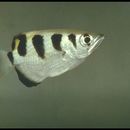en
names in breadcrumbs


VISION:
T. jaculatrix is able to control its vision in such a way as to make the index of refraction of water to air negligible (it can see from water to air without any distortions in spacial arrangerment) so that it can easly track and "shoot" its airborn prey. T. jaculatrix accomplishes this through special adatations in the eye which give the fish an unusually large area on the retina in which the Archerfish can focus an image and still have it be clear.(Brown,1957) This adaptation allows the Archerfish to look through water into the air without having to take into account any distortions in spacial arrangement that come about due to the differences in the indices of refraction of water and air.
One other possible way the Archerfish deals with minimizing the indices of refraction of water is by lining up almost directly underneath its prey before shooting, thus making the effective difference in what the Archerfish sees from the water compared to what it would see from the air almost null. (Luling, 1963)
SPITTING- the reason it's called the "Archerfish":
The way in which the Archerfish spits water at its prey is not known in great detail, but the following information is known. The Archerfish is able to spit water by building up pressure in the mouth by producing for on the bones of the mouth (hyoid and lower jaw), while at the same time closing off any passage for water to any place besides the front of the mouth. These actions in turn produce a positive pressure which forces the water inside the mouth to be forcefully ejected from the small opening at the front of the mouth. (Elshoud, 1985)
Perception Channels: tactile ; chemical
Information on this species is sparse but because it is a very popular aquarium fish one could assume it is not endangered. The Virtual Science Centre Project says that the Archerfish "is fairly common" but that the destruction of mangrove swamps could cause a great decline in its numbers. (Virtual Science Project, 1996)
T. jaculatrix is widely sought after as an aquarium fish.
T. jaculatrix feeds mainly on terrestrial insects by spitting water at them, thus knocking them out of the air and into the water. For this reason, T. jaculatrix is called the "Archerfish". T. jaculatrix can shoot its prey from as far as 125cm away. The Archerfish is also known to eat worms, shrimp, and other small animals. (Virtual Science Centre, 2000; Tropical Tank, 2000; About, 2000; Nelson, 1994)
Toxotes jaculatrix can be found in India, New Guinea, Australia, the Phillipines, Southeast Asia, and Oceania. (ISIS, 2000; Virtual Science Centre Project, 1996)
Biogeographic Regions: oriental (Native ); australian (Native ); indian ocean (Native ); pacific ocean (Native )
T. jaculatrix is found almost exclusively in mangrove swamps, but can also be found to varying degrees in prawn ponds and river mouths (Tropical Tank, 2000; FreshAquariam, 2000). T. jaculatrix can survive in a wide range of water habitats, from fresh water to salt water, and in temperatures ranging from 25 to 30 degrees C (Tropical Tank, 2000). In almost all instances T. jaculatrix is found at or near the top depths of its aquatic environment, thus facilitating its predatory habits. (Neale, no date)
Aquatic Biomes: lakes and ponds; rivers and streams; coastal
T. jaculatrix is approximately 25 cm in length on average and has variable coloring, but is almost always silver-bodied with black vertical stripes or has a yellow hue with black stripes. (Tropical Tank 2000; Nelson 1994)
Other Physical Features: bilateral symmetry
Reproductive habits of T. jaculatrix have not been formally studied at this time.